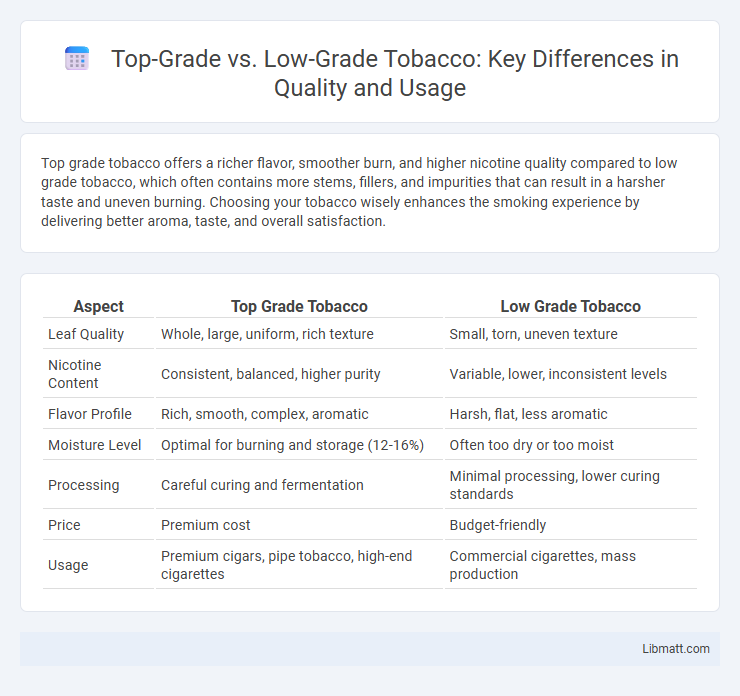Top grade tobacco offers a richer flavor, smoother burn, and higher nicotine quality compared to low grade tobacco, which often contains more stems, fillers, and impurities that can result in a harsher taste and uneven burning. Choosing your tobacco wisely enhances the smoking experience by delivering better aroma, taste, and overall satisfaction.
Table of Comparison
| Aspect | Top Grade Tobacco | Low Grade Tobacco |
|---|---|---|
| Leaf Quality | Whole, large, uniform, rich texture | Small, torn, uneven texture |
| Nicotine Content | Consistent, balanced, higher purity | Variable, lower, inconsistent levels |
| Flavor Profile | Rich, smooth, complex, aromatic | Harsh, flat, less aromatic |
| Moisture Level | Optimal for burning and storage (12-16%) | Often too dry or too moist |
| Processing | Careful curing and fermentation | Minimal processing, lower curing standards |
| Price | Premium cost | Budget-friendly |
| Usage | Premium cigars, pipe tobacco, high-end cigarettes | Commercial cigarettes, mass production |
Understanding Tobacco Grades: An Overview
Top grade tobacco features superior leaf quality, richer flavor profiles, and consistent burn rates, making it ideal for premium cigars and cigarettes. Low grade tobacco often contains more stems, irregular leaf size, and harsher taste, resulting in less desirable smoking experiences. Understanding these tobacco grades helps you select products that match your quality preferences and smoking style.
Key Differences Between Top Grade and Low Grade Tobacco
Top grade tobacco features richer flavor profiles, higher nicotine content, and cleaner leaves due to meticulous harvesting and curing processes, making it preferred for premium cigars and cigarettes. Low grade tobacco often contains more stems, heavier chemical residues, and inconsistent leaf quality, resulting in harsher taste and reduced smoothness. Your smoking experience and product quality greatly depend on choosing top grade tobacco over low grade varieties.
Visual Characteristics: Appearance and Color
Top grade tobacco features uniformly rich, golden-brown leaves with fine veins and a smooth texture, indicating superior curing and handling processes. Low grade tobacco often shows uneven coloration, including darker spots or yellowing, with rough, brittle leaves reflecting lower quality and inconsistent drying. Your choice in visual quality directly influences the flavor and burn consistency of the tobacco product.
Leaf Texture and Structure Comparison
Top grade tobacco leaves exhibit a smooth, uniform texture with well-defined veins and a consistent thickness, contributing to an even burn and rich flavor profile. In contrast, low grade tobacco leaves often display a coarse, uneven texture with irregular vein patterns and variable thickness, resulting in a harsher taste and uneven combustion. The structural integrity of premium leaves supports better moisture retention, enhancing the overall smoking experience compared to the brittle and fibrous nature of lower quality leaves.
Flavor Profile: Smoothness vs. Harshness
Top grade tobacco offers a rich, smooth flavor profile with nuanced notes that enhance your smoking experience, while low grade tobacco often delivers a harsh, bitter taste due to lower quality leaves and processing methods. The smoothness of premium tobacco results from careful curing and superior leaf selection, reducing bitterness and harshness. Choosing high-quality tobacco ensures a more enjoyable, refined flavor that is less likely to irritate your throat.
Nicotine Content: Potency Variations
Top grade tobacco typically contains higher nicotine content, resulting in stronger potency and a more intense smoking experience compared to low grade varieties. Low grade tobacco often has reduced nicotine levels, leading to milder effects and less pronounced stimulant properties. The variation in nicotine concentration directly influences the overall strength, flavor, and satisfaction perceived by smokers.
Aroma and Scent Distinctions
Top grade tobacco offers a rich, complex aroma with subtle notes of earthiness, sweetness, and spice, whereas low grade tobacco often emits a harsh, stale scent with fewer nuanced layers. The fragrance of premium tobacco enhances your smoking experience by providing a smooth, inviting scent that lingers pleasantly. Choosing top grade tobacco ensures a superior sensory profile that low grade varieties simply cannot match.
Health Implications: Quality vs. Safety
Top grade tobacco typically contains fewer harmful additives, resulting in relatively lower exposure to toxins and carcinogens compared to low grade tobacco, which often includes more contaminants that increase health risks. Studies show that smoking low grade tobacco can lead to higher incidences of respiratory diseases and cardiovascular issues due to the presence of impurities and chemical residue. Consumers seeking safer options should prioritize quality-controlled tobacco products to minimize adverse health implications linked to toxic compounds found in inferior tobacco.
Consumer Preferences and Market Trends
Top grade tobacco, favored for its superior flavor, aroma, and smoother smoking experience, commands a premium price and attracts discerning consumers seeking quality and luxury. Low grade tobacco, characterized by harsher taste and lower nicotine content, appeals primarily to budget-conscious buyers and markets with less stringent regulations. Market trends show a growing preference for top grade tobacco in developed regions, driven by increased health awareness and demand for premium products, while low grade tobacco maintains significant share in emerging markets due to affordability.
Price Differences: Value for Money Analysis
Top grade tobacco commands a higher price due to superior flavor, aroma, and quality control, offering a more refined smoking experience. Low grade tobacco is significantly cheaper but tends to lack consistency and delivers a harsher taste, impacting overall satisfaction. When evaluating value for money, you should consider whether the enhanced quality of top grade tobacco justifies the premium cost based on your smoking preferences and frequency.
Top grade vs low grade tobacco Infographic

 libmatt.com
libmatt.com